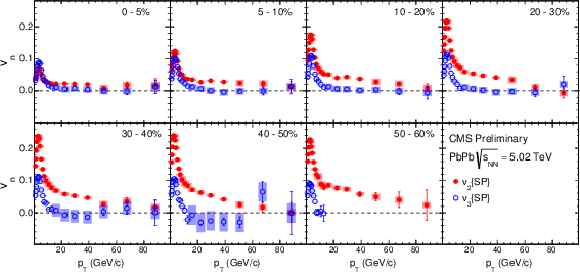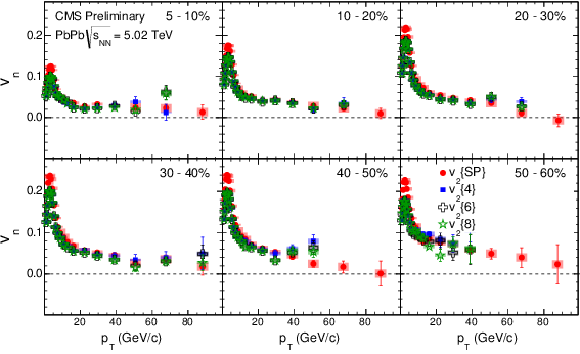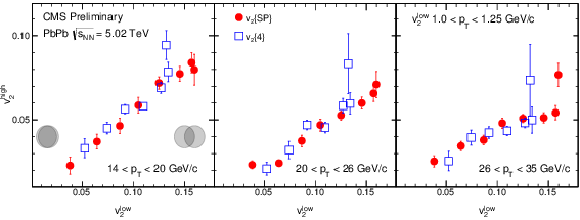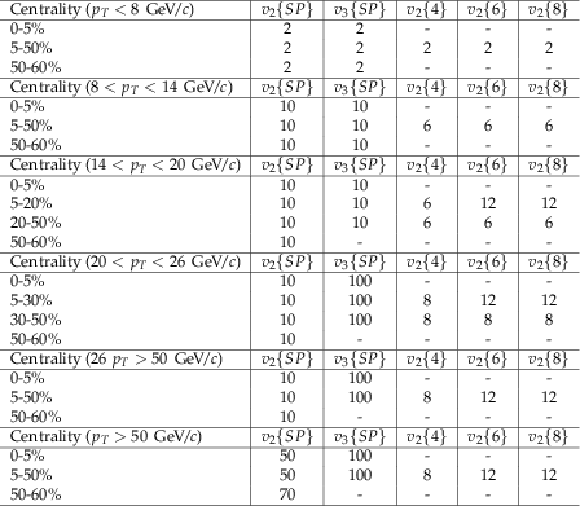

Compact Muon Solenoid
LHC, CERN
| CMS-PAS-HIN-15-014 | ||
| High-pT track vn harmonics in PbPb collisions at 5.02 TeV | ||
| CMS Collaboration | ||
| May 2016 | ||
| Abstract: The Fourier coefficients (n = 2, 3) of the azimuthal distributions of charged particles produced in PbPb collisions at √sNN= 5.02 TeV is measured with the CMS detector at the LHC over an extended transverse momentum (pT) range up to approximately 100 GeV/c. The data cover both the low-pT region (1 <pT< 3 GeV/c) associated with hydrodynamic flow phenomena and the high-pT region where anisotropic azimuthal distributions may reflect the path-length dependence of parton energy loss in the created medium. Several methods were used to extract the Fourier coefficients, such as the scalar product method that correlating charged tracks with the energy deposited in the hadronic forward calorimeters, or multi-particle cumulant method. For the seven bins of collision centrality studied, spanning the range of 0-60% most-central events, the observed v2 values are found to first increase with pT, reaching a maximum around pT= 3 GeV/c and then to gradually decrease. In the most central (0-5%) events, non-zero v2 is observed above ≈ 30 GeV/c and it is found to be constant as function of pT. | ||
|
Links:
CDS record (PDF) ;
inSPIRE record ;
CADI line (restricted) ;
These preliminary results are superseded in this paper, PLB 776 (2017) 195. The superseded preliminary plots can be found here. |
||
| Figures | |

png pdf |
Figure 1:
The v2 and v3 results from SP method as a function of pT in seven centrality ranges of PbPb collisions at √sNN= 5.02 TeV. Shaded boxes represent systematic uncertainties. |

png pdf |
Figure 2:
The v2 results from SP and EP method as a function of pT in seven centrality ranges of PbPb collisions at √sNN= 5.02 TeV and 2.76 TeV respectively. Shaded boxes represent systematic uncertainties and dashed lines are predictions from CUJET3.0 model [26,27]. |

png pdf |
Figure 3:
Comparison between the v2 results from SP and cumulant methods as a function of pT in six centrality ranges of PbPb collisions at √sNN= 5.02 TeV. Shaded boxes represent systematic uncertainties. |

png pdf |
Figure 4:
The v2 values from different centrality ranges at high pT : 12 <pT< 14 GeV/c, 20 <pT< 26 GeV/c and 26 <pT< 35 GeV/c vs. low pT (1 <pT< 1.25 GeV/c) obtained from SP (closed circles) and cumulant (open squares) methods in PbPb collisions at √sNN= 5.02 TeV. |
| Tables | |

png pdf |
Table 1:
Sources of systematic uncertainties and range of uncertainties in percent. |

png pdf |
Table 2:
Total systematic uncertainties in percentage |
| Summary |
| In summary, the azimuthal anisotropy of charged particles with respect to the event plane has been studied in PbPb collisions at √sNN= 5.02 TeV using the CMS detector. The v2 and v3 coefficients were determined over a wide range in pT from 1 GeV/c to approximately 100 GeV/c, as a function of collision centrality using scalar product method. The results reported in this paper significantly improve the statistical precision of previous v2 measurements at lower energy for 12 <pT< 60 GeV/c, and explore for the first time the very high pT region beyond 60 GeV/c. Furthermore, these results provide a v3 measurement up to a pT region that has never before been studied (up to 100 GeV/c). The v2(pT) behavior shows a trend of rapid rise to a maximum at pT≈ 3 GeV/c and a subsequent fall for all centrality ranges. Beyond pT≈ 10 GeV/c, the observed v2 values still show some pT dependence but with a more moderate decrease with pT, remaining finite up very high pT. The v3(pT) behavior is very similar to v2 at low pT but its value is consistent with zero over the full centrality range for pT> 20 GeV/c. A common trend in the centrality dependence of v2 is observed for particles over a wide range of pT, suggesting a potential connection to the initial-state geometry. To further investigate the origin of the correlation at high pT, a multi-particle correlation analysis was performed to extract v2 from 1 GeV/c to, at maximum, 100 GeV/c. At low pT, v2{4}, v2{6} and v2{8} have similar values and smaller than v2{SP}. This follows hydrodynamic expectations and is a sign of collectivity. The same behavior is observed at high pT and reflects the collective nature of these correlations. Finally, we have investigated the correlations between v2 values at low and high pT as a function of centrality and they appeared to be strongly correlated. The low and high pT correlations are respectively driven by the collective expansion and by the path lenght dependence of hard-scattered partons in the medium. These results indicate that the initial geometry and its fluctuations are responsible for both low and high pT correlations. The precision data over a wide kinematic range presented here will provide important constraints on models of parton energy loss, particularly in terms of its dependence on the initial conditions, parton energy and path length through the medium. |
| References | ||||
| 1 | BRAHMS Collaboration | Quark gluon plasma and color glass condensate at RHIC? The perspective from the BRAHMS experiment | Nucl. Phys. A 757 (2005) 1 | nucl-ex/0410020 |
| 2 | PHENIX Collaboration | Formation of dense partonic matter in relativistic nucleus-nucleus collisions at RHIC: Experimental evaluation by the PHENIX collaboration | Nucl. Phys. A 757 (2005) 184 | nucl-ex/0410003 |
| 3 | PHOBOS Collaboration | The PHOBOS perspective on discoveries at RHIC | Nucl. Phys. A 757 (2005) 28 | nucl-ex/0410022 |
| 4 | STAR Collaboration | Experimental and theoretical challenges in the search for the quark gluon plasma: The STAR Collaboration's critical assessment of the evidence from RHIC collisions | Nucl. Phys. A 757 (2005) 102 | nucl-ex/0501009 |
| 5 | ATLAS Collaboration | Observation of a Centrality-Dependent Dijet Asymmetry in Lead-Lead Collisions at √sNN = 2.76TeV with the ATLAS Detector at the LHC | PRL 105 (2010) 252303 | 1011.6182 |
| 6 | CMS Collaboration | Observation and studies of jet quenching in PbPb collisions at nucleon-nucleon center-of-mass energy = 2.76 TeV | PRC 84 (2011) 024906 | CMS-HIN-10-004 1102.1957 |
| 7 | A. Majumder and M. Van Leeuwen | The Theory and Phenomenology of Perturbative QCD Based Jet Quenching | Prog. Part. Nucl. Phys. A 66 (2011) 41 | 1002.2206 |
| 8 | J. Noronha-Hostler, B. Betz, J. Noronha, and M. Gyulassy | Soft-Hard Event Engineering in Ultrarelativistic Heavy Ion Collisions | 1602.03788 | |
| 9 | S. Peigne and A. V. Smilga | Energy losses in a hot plasma revisited | Phys. Usp. 52 (2009) 659 | 0810.5702 |
| 10 | S. Wicks et al. | Elastic, Inelastic, and Path Length Fluctuations in Jet Tomography | Nucl. Phys. A 784 (2007) 426 | nucl-th/0512076 |
| 11 | J. Jia and R. Wei | Dissecting the role of initial collision geometry for jet quenching observables in relativistic heavy ion collisions | PRC 82 (2010) 024902 | 1005.0645 |
| 12 | J. Jia, W. Horowitz, and J. Liao | A study of the correlations between jet quenching observables at RHIC | PRC 84 (2011) 034904 | 1101.0290 |
| 13 | T. Renk | Pathlength dependence of energy loss within in-medium showers | PRC 83 (2011) 024908 | 1010.4116 |
| 14 | B. Betz, M. Gyulassy, and G. Torrieri | Fourier Harmonics of High-pT Particles Probing the Fluctuating Intitial Condition Geometries in Heavy-Ion Collisions | PRC 84 (2011) 024913 | 1102.5416 |
| 15 | B. Betz and M. Gyulassy | Reduced Jet-Medium Coupling in Pb+Pb Collisions at the LHC? | 1201.0281 | |
| 16 | PHENIX Collaboration | Azimuthal anisotropy of neutral pion production in Au+Au collisions at √sNN = 200~GeV: Path-length dependence of jet quenching and the role of initial geometry | PRL 105 (2010) 142301 | 1006.3740 |
| 17 | M. Luzum and J.-Y. Ollitrault | Eliminating experimental bias in anisotropic-flow measurements of high-energy nuclear collisions | Phys.Rev. C87 (2013), no. 4, 044907 | 1209.2323 |
| 18 | CMS Collaboration | Azimuthal anisotropy of charged particles at high transverse momenta in PbPb collisions at √sNN=2.76 TeV | PRL 109 (2012) 022301 | CMS-HIN-11-012 1204.1850 |
| 19 | S. A. et al. | Geant4 -- a simulation toolkit | Nuclear Instruments and Methods in Physics Research Section A: Accelerators, Spectrometers, Detectors and Associated Equipment 506 (2003), no. 3, 250 -- 303 | |
| 20 | CMS Collaboration | The CMS Experiment at the CERN LHC | JINST 03 (2008) S08004 | CMS-00-001 |
| 21 | A. M. Poskanzer and S. A. Voloshin | Methods for analyzing anisotropic flow in relativistic nuclear collisions | PRC 58 (1998) 1671 | nucl-ex/9805001 |
| 22 | E877 Collaboration | Proton and pion production relative to the reaction plane in Au + Au collisions at 11-A-GeV/c | PRC56 (1997) 3254--3264 | nucl-ex/9707002 |
| 23 | STAR Collaboration | Elliptic flow from two and four particle correlations in Au+Au collisions at s(NN)**(1/2) = 130-GeV | Phys.Rev. C66 (2002) 034904 | nucl-ex/0206001 |
| 24 | A. Bilandzic, R. Snellings, and S. Voloshin | Flow analysis with cumulants: Direct calculations | Phys.Rev. C83 (2011) 044913 | 1010.0233 |
| 25 | A. Bilandzic et al. | Generic framework for anisotropic flow analyses with multiparticle azimuthal correlations | Phys.Rev. C89 (2014), no. 6, 064904 | 1312.3572 |
| 26 | X. Jiechen, L. Jinfeng, and M. Gyulassy | Consistency of Perfect Fluidity and Jet Quenching in Semi-Quark-Gluon Monopole Plasmas | Chinese Physics Letters 32 (2015), no. 9, 092501 | |
| 27 | J. Xu, J. Liao, and M. Gyulassy | Bridging soft-hard transport properties of quark-gluon plasmas with CUJET3.0 | Journal of High Energy Physics 2016 (2016), no. 2, 1--50 | |

|
Compact Muon Solenoid LHC, CERN |

|

|

|

|

|

|